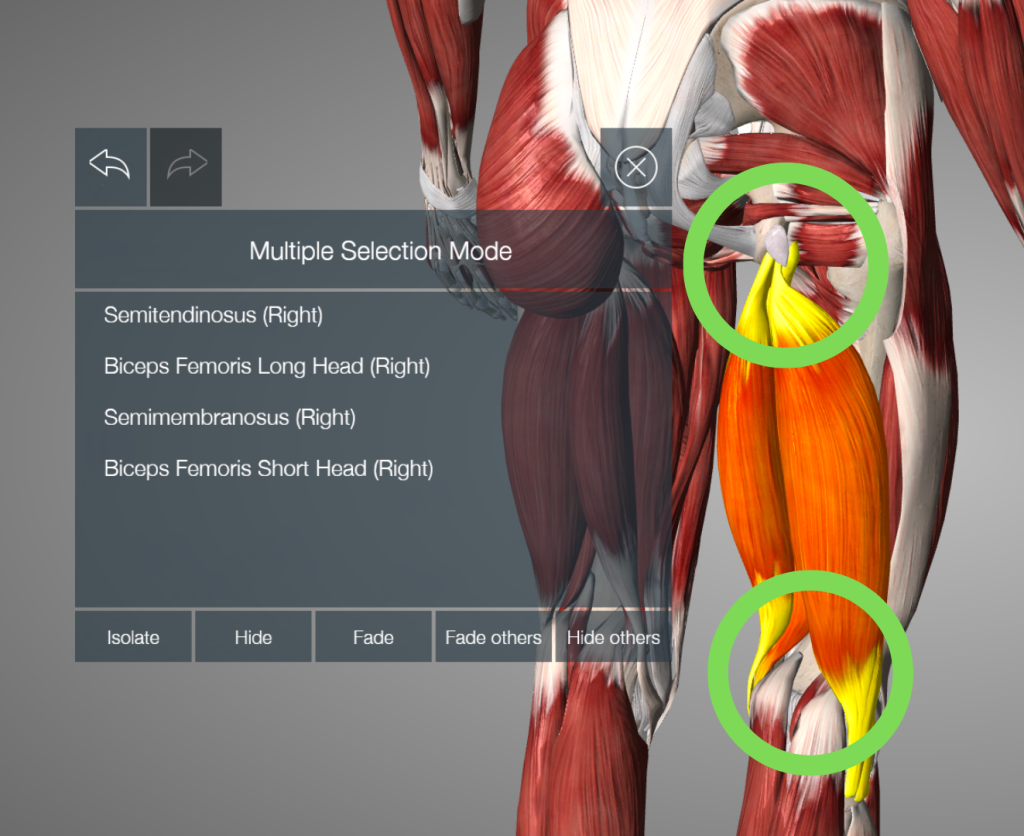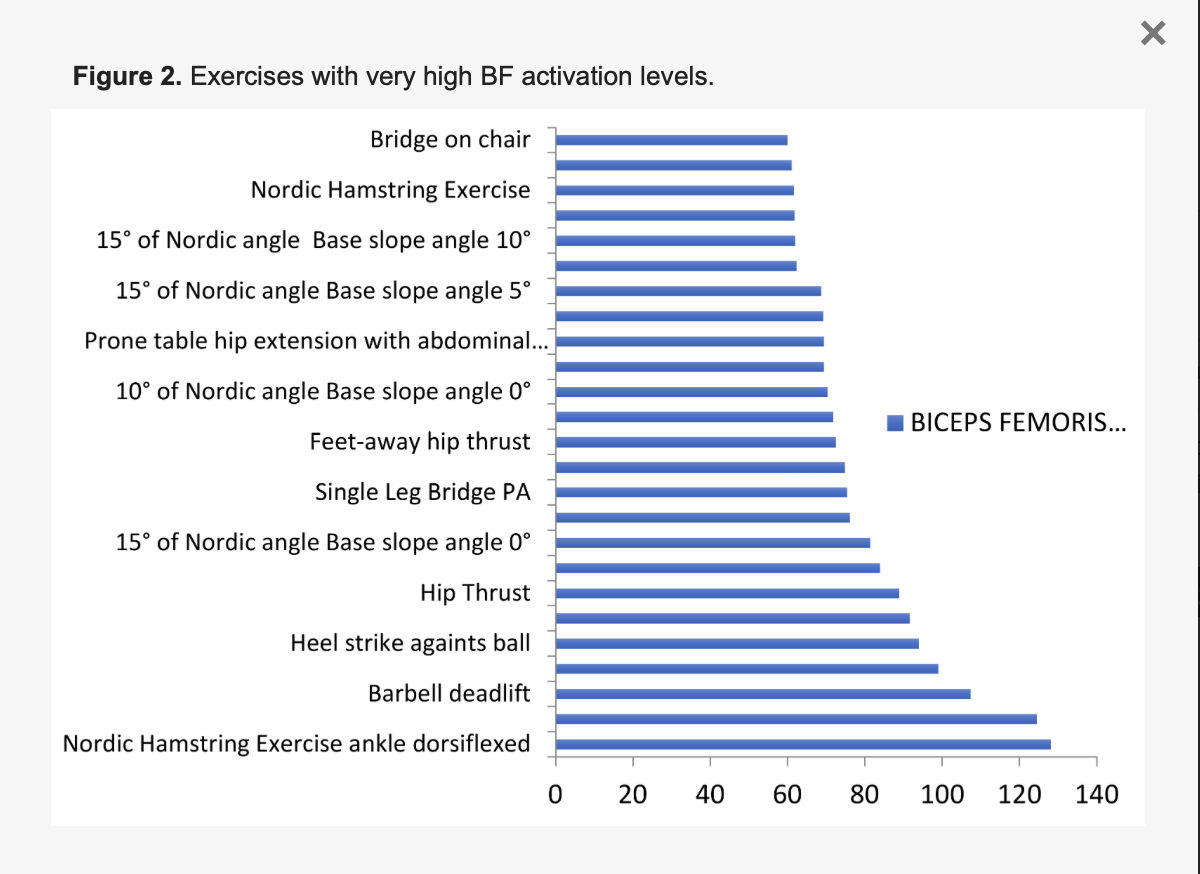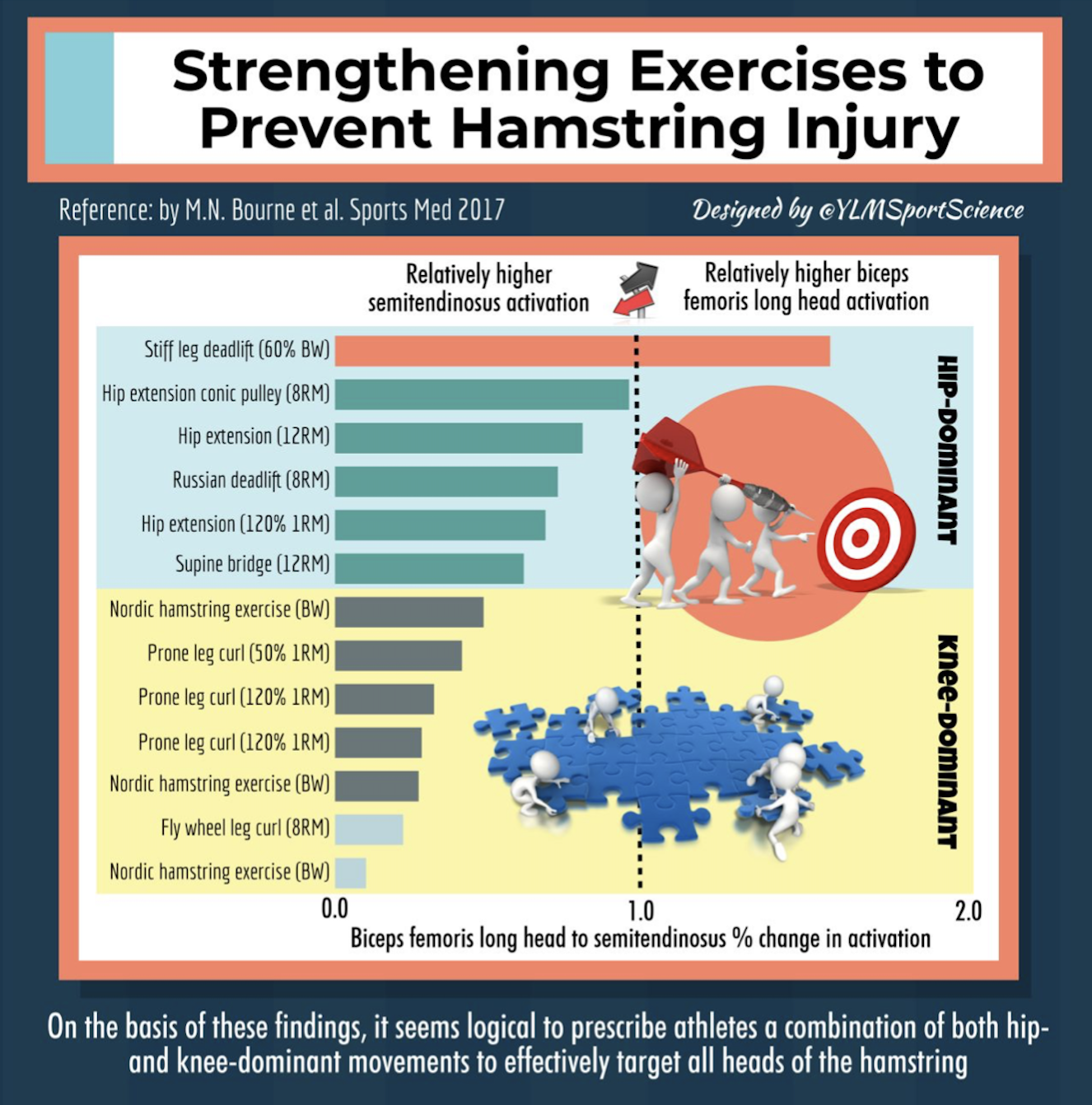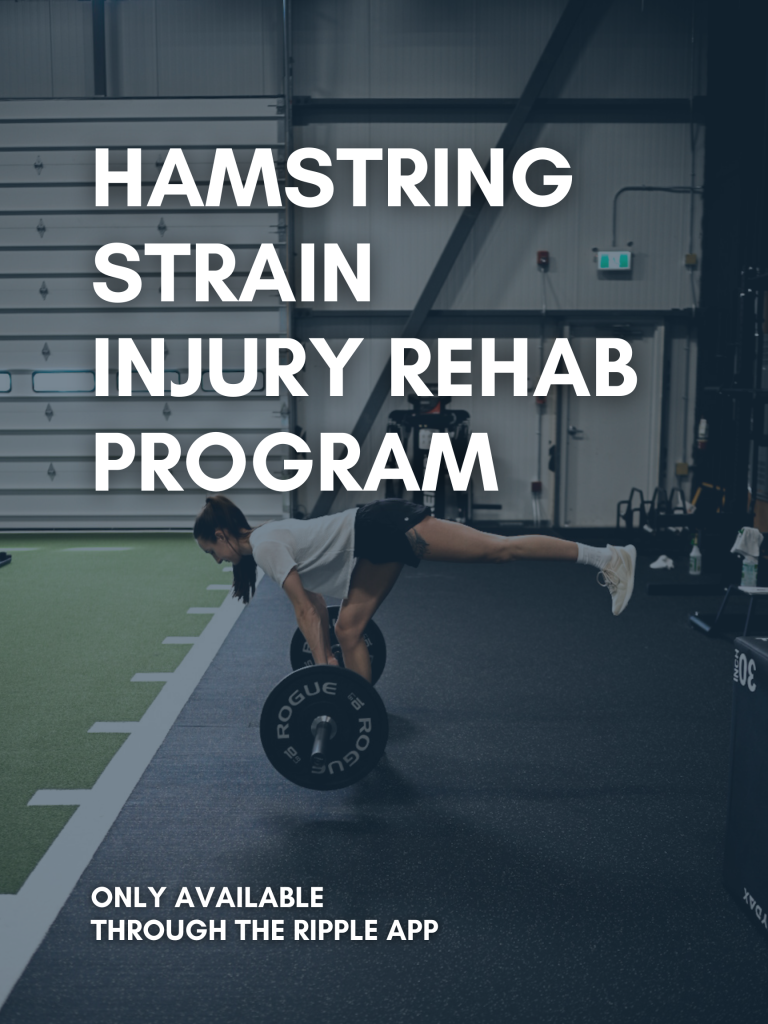Target all of your hamstring muscles by completing both hip dominant and knee dominant movements.
Whether you are recovering from a hamstring injury or trying to prevent it, you should include:
- Hip dominant exercises – bending at the hip e.g. hip hinges
- Knee dominant exercises – bending at the knee e.g. leg curls
- Fast exercises – e.g. sprinting and chronic high speed running
- Heavy resistance training – e.g. leg curls, hip thrusts, deadlifts
- Eccentric exercises – e.g. nordics, RDLs
Hamstring injuries often happen in sprinting and change of direction sports. Re-injuring the same muscle after a hamstring injury is a common occurrence.
The hamstrings are a group of muscles that run down the back of your thigh, and training them is essential for sport performance and increasing your ‘envelope of function’ to reduce your likelihood of injuring this muscle group.



You can have different types of hamstring injuries. This can generally be diagnosed by a physiotherpist, however, the most accurate diagnosis would come from an MRI. Many recreational athletes would not require imaging for their hamstring injury.
The broad categories of hamstring injuries are (1):
- Myofascial – these occur in the muscle belly
- Musculotendinous – these occur where the muscle becomes tendon
- Tendinous – these occur mostly within the tendon
Preventing Hamstring Injury and Reducing Risk of Re-Injury
Your hamstring muscles can help with:
- Knee stability as they attach on both sides of the knee joint
- Protective role for your ACL (anterior cruciate ligament) by preventing the anterior translation of our tibia (lower shin bone)
- Improve cutting, landing, deceleration and change of direction movements
- Sprinting performance
Unfortunately, injuries aren’t as simple as “get stronger and never be injured” (2), however, by adding certain strengthening exercises to your rehab and training, you are likely increasing your ‘envelope of function’ – meaning your body, and specifically your hamstrings, can handle more demands before breaking course and contributing to an injury.
Why should you train knee and hip dominant movements?
The hamstring muscles cross at the knee joint and the hip joint so multiple exercises are needed to target both of these areas. The top circle shows the hamstring muscles originating at your pelvis, and the lower circle shows the hamstring muscles attaching on both sides of the knee.

Types of hamstring exercises
Targeting Different Hamstring Muscles
The charts below show how you can bias different hamstring muscles in different exercises. It is important to remember that:
- All of your hamstring muscles will still be working during these exercises, the studies were just looking into which ones may be biased to work harder.
- These are generalizations, and your body will choose the muscle strategy that works for you.
- This means that it is likely best to still perform a variety of exercises to ensure you are targeting the multiple muscles of the hamstring group.
Targeting the Lateral Hamstrings
This chart shows exercises from least to greatest muscle use of the biceps femoris (the outer or lateral hamstring muscle) (3). It has a long head and a short head.
The hip thrust, heel strikes against a ball and nordic hamstring exercise (with ankle bent) were great for activating this muscle.

Heel strikes against ball video:
This is an exercise that is used in the Hamstring Strain Injury Rehab Program on Ripple.
Stiff legged deadlift video:
This video is an exercise taken from the Hamstring Injury Rehab Program on Ripple.
Targeting the Medial Hamstrings
This chart shows how some exercises can target the semitendinosus hamstring muscle more (one of the inner or medial muscles) (4).
The summary of this chart is that:
- Knee bending exercises (like the prone curl, bent knee bridge, and glute-ham raise)
- It also found high medial hamstring activation with nordic exercises
- Eccentric and hip extension exercises actually targeted the outer hamstrings more

TL;DR
- Hip dominant exercises, like the stiff legged deadlift and hip extensions to target lateral hamstrings more
- Knee dominant exercises tend to target medial hamstrings more
- Include nordic hamstring exercises as an eccentric exercise for all hamstring muscles, particuarly lateral hamstrings due to it’s eccentric nature
- Include knee curl exercises to bias the medial hamstrings more
Hamstring Injury Recovery Timelines
- Myofascial – these recover the quickest, and can occurr in any of the muscle bellies of the hamstrings, but commonly in the biceps femoris during sprinting
- Musculotendinous – these occur where the muscle becomes tendon, and can take longer to heal, an example would be the t-junction injury
- Tendinous – these occur mostly within the tendon and take the longest to recover from
Recovery from a hamstring injury takes time, as mentioned above, it also depends on the type of hamstring injury you sustained. With different types of exercises, we can bias different hamstring muscle groups. This is important depending which muscle, or musculotendinous unit, was injured.
With any type of muscle injury, it is important to go through all the phases of rehab (acute, foundations, strength, return to activity, and return to sport) to try and increase the robustness of your hamstring muscles and surrounding joints.

If you are looking for a full program for hamstring strain recovery and rehab, check out the Hamstring Injury Program – it takes you from acute injury through to sprinting, with video demonstrations and explanations.
References
- Paton, Bruce M., et al. “London International Consensus and Delphi study on hamstring injuries part 3: rehabilitation, running and return to sport.” British journal of sports medicine57.5 (2023): 278-291.
- Opar DA, Timmins RG, Behan FP, Hickey JT, van Dyk N, Price K, Maniar N. Is pre-season eccentric strength testing during the Nordic hamstring exercise associated with future hamstring strain injury? A systematic review and meta-analysis. Sports Medicine. 2021 Sep;51(9):1935-45.
- Llurda-Almuzara L, Labata-Lezaun N, López-de-Celis C, Aiguadé-Aiguadé R, Romaní-Sánchez S, Rodríguez-Sanz J, Fernández-de-las-Peñas C, Pérez-Bellmunt A. Biceps Femoris Activation during Hamstring Strength Exercises: A Systematic Review. International Journal of Environmental Research and Public Health. 2021; 18(16):8733. https://doi.org/10.3390/ijerph18168733
- Bourne, M.N., Timmins, R.G., Opar, D.A. et al. An Evidence-Based Framework for Strengthening Exercises to Prevent Hamstring Injury. Sports Med 48, 251–267 (2018). https://doi.org/10.1007/s40279-017-0796-x
- Bourne MN, Williams MD, Opar DA, Al Najjar A, Kerr GK, Shield AJ. Impact of exercise selection on hamstring muscle activation. British journal of sports medicine. 2017 Jul 1;51(13):1021-8.
- Crawford, S.K., Hickey, J., Vlisides, J. et al. The effects of hip- vs. knee-dominant hamstring exercise on biceps femoris morphology, strength, and sprint performance: a randomized intervention trial protocol. BMC Sports Sci Med Rehabil 15, 72 (2023). https://doi.org/10.1186/s13102-023-00680-w
- Aurélie Boyer, François Hug, Simon Avrillon & Lilian Lacourpaille (2021): Individual differences in the distribution of activation among the hamstring muscle heads during stiff-leg Deadlift and Nordic hamstring exercises, Journal of Sports Sciences, DOI:10.1080/02640414.2021.1899405
- Mendiguchia J, Martinez-Ruiz E, Edouard P, Morin JB, Martinez-Martinez F, Idoate F, Mendez-Villanueva A. A multifactorial, criteria-based progressive algorithm for hamstring injury treatment. Med Sci Sports Exerc. 2017 Jul 1;49(7):1482-92.



